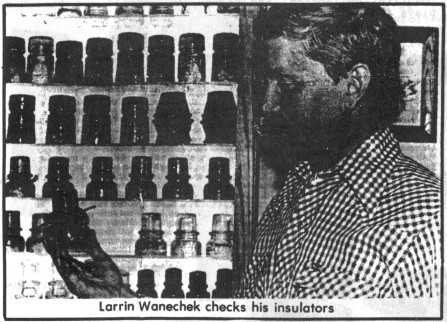Insulator Collector Learns Bits Of History
Reprinted from "Crown Jewels of the Wire", November 1990, page 26
From the Daily Record Ellensburg, Washington, April 16, 1990
By PAT WOODELL
Contributing Writer
In the steep hillside, reaching above a
tangle of overgrown brush and weeds, the abandoned telegraph pole held high a
small, light purple treasure.
"As soon as I saw it, I knew it was a real
find," said Larrin Wanechek, of the rural Cle Elum area. "I had my
climbing spurs with me, so it didn't take long to climb that 70-foot pole to get
the only light purple low-domed #1678 telegraph insulator that I have in my
collection."
Larrin Wanechek, an avid collector of telegraph/telephone
insulators since 1974, has remodeled an entire room in his Upper Kittitas County
home to accommodate his collection. Five glass cases with special back-lighting
highlight the insulators in their full rainbow colors. The exhibit is
supplemented by 'go-withs,' those special items that go with the world of
insulators such as old telephones, tie wires, sideblocks, and sections of
outdated telegraph poles.

Glass battery Jars, no longer containing acid and lead
plates to power the telegraph, are filled with 'tear-jerker' pieces of broken
antique insulators, many over 100 years old, some with bits of cold-rolled tie-wire still attached. Historical charts and pictures of the old Collins
Overland Telegraph Line which provide the history background of the Wanechek
collection round out the exhibit.
"At first I collected insulators because it was at that time, I was
working for the British Telephone Co. and the few discarded insulators I took
home made bright decorations for the window sill," said Wanechek.
His
interest didn't stop there. Caught up in the world of consolidated design
numbers, tall beehives and two-piece transpositions, he soon bought a small
collection, did some trading, and set out to find for himself those rare and
unusual insulators which some collectors "would die for."
"Unusual insulators are often found near old or abandoned telegraph
lines," said Wanechek. "And in 1974, I was working near one of the
oldest telegraph lines in British Columbia, the Collins Overland Telegraph Line.
A study of its history provided the treasure map clues that I needed."
According to Wanechek, the Collins Line, in a race with the trans-Atlantic
cable, was the ambitious attempt to link North America to Europe and Asia by
telegraph. Promoted by Perrie McDonough Collins and financed by Western Union
Telegraph, the construction, which began in 1861, went from the east coast to
San Francisco, up the coast through the Oregon Territory and, by 1885, into
British Columbia.
In Canada, the line gangs pushed through the wilderness along
the Caribou Trail road from New Westminster to Quesnel to Fort Stager near the
Alaska border. Supplies, which had been shipped at great cost from the east
coast, were hauled by ox teams to cache sites along the route. Unfortunately for
the Collins Line the trans-Atlantic cable succeeded in linking the United
States with Europe in July 1866. The race was lost.
Line gangs, working
simultaneously in Siberia, Russia, Alaska and at Fort Stager in British
Columbia, abandoned everything, including the cache sites filled with hundreds
of spools of wire and thousands of barrels of insulators and sideblocks.
Wanechek has in his collection the three kinds of threadless insulators used in
the original Collins line: the Chesters, the Tillotsons and the Mulford and
Biddles.
"I found a cache of Chester insulators, which had been shipped
from New York state, up near the Alaskan border," he said. "And it is recorded that long ago Indians
found these flat-topped Chester insulators and used them for cups."
One
piece of a Chester insulator had the imprint of a wire on it. "Here is
evidence that sometime during the past 100 years that cache had gone through a
fire," said Wanechek.
According to Wanechek, part of the Collins Line south
of Quesnel, B.C. is still in use today. It was here during the 1870s that the
threadless insulators were replaced by the more efficient threaded ones from E.C.
and M. Co., Cal Electric Works and McMicking. (The line is still in existence,
but all of the insulators have been updated.)
"I found this Cal Electric
replacement insulator near Cache Creek in British Columbia," said Wanechek.
"Someone who was wrecking out the old telegraph line had thrown it 150 feet
towards some rocks; but instead of breaking, it landed in a bed of moss, where I
found it.
"I also found a cache of McMickings dated 1875 near the Thompson River
in British Columbia. They were brought to the site on a stern-wheeler up the
river; but the line was never started."
Today, with 525 threaded and 40 threadless insulators, Wanechek is still an
avid collector of the rare and unusual. Each year he returns to British Columbia
to explore the route of the Collins Line for treasures.
"Along the trail, I
have found more than insulators: worn-out Ox shoes from the ox teams, and
oriental objects like a ginger jar, a porcelain jar, and an opium bottle left by
Chinese coolies," said Wanechek. "There's so much country out there
and it is so changed that when I am looking for an insulator on an abandoned
telegraph pole it is like hunting for a needle in a haystack."
To some people it might seem impossible, but not to Wanechek -- he has done it.
| 